Nara
last update: February 18, 2023
Nara (奈良) is a city of over 300,000 inhabitants, capital of the prefecture of the same name. It is located just 30 km away from Osaka as the crow flies, and is one of the most visited cities in the Kansai region, a UNESCO World Heritage Site since 1998. Nara, which was called Heijo at the time, was in fact capital of Japan from 710 to 784. For the first time in history, Japan had a permanent capital, as prior to that year the capital was moved to a new location each time a new emperor ascended to throne. Today, the city has an immense historical and cultural heritage and is also famous as the city of deer, sacred animals of the Shinto religion that roam freely in this city through the parks, fearlessly approaching curious visitors.
Things to do and things to see in Nara
Despite its small size, Nara is one of the most interesting and must-see cities in all of Japan. The typical itinerary for the foreign tourist in Nara generally consists of a stroll through the vast
Nara Park, where one can easily spend half a day or even more. Here you meet the famous sacred deer, as well as some famous temples and shrines of the city such as Todaiji and Kasuga Taisha, and some traditional gardens and small museums. After lunch, perhaps someone has time for a walk in the nearby Naramachi area, with its old wooden buildings, before returning to the station (usually before evening) to catch the train to Osaka or Kyoto. If you're short on time, this is what you should see in Nara. If, on the other hand, you want a more unique experience, it is better to spend at least one night in Nara, so as to explore other areas at your leisure. The choice is wide: in addition to Nara Park (a must see for anyone) and Naramachi (interesting but there are many other similar areas in the rest of the country), the city offers a
vast archaeological area of the no longer existing Heijo Imperial Palace, many other
temples, distant from the center but of immense value (such as the
Toshodaiji, the
Yakushiji and the temples of the town of
Ikaruga), a thousand-year-old forest crossed by some hiking trails (
Mount Kasuga) and a panoramic view from the summit of Mount Wakakusa, which catches fire at the end of January during a unique-in-the-world festival (
Wakakusa Yamayaki).
Nara Park
Nara Park (奈良公園, Nara Kōen) is a vast public park in the center of the city of Nara, at the foot of
Mount Wakakusa, the number one destination for tourists who visit the city. The most important Buddhist temple (
Todaiji) and the most important Shinto shrine (
Kasuga Taisha) another Buddhist temple (
Kofukuji ) and a Buddhist art museum (
Nara National Museum) are all located within this park. The park is also famous throughout Japan because
over 1000 sika deer roam freely inside. The sika deer is, for the Shinto religion, a sacred animal. According to legend, the deity Takemi Kajichi no Mikoto (God of Thunder), arrived in Nara riding a white deer. For this reason, the deer of Nara were themselves considered deities and until 1637, the killing of one of these deer could be punished with death. The status of "divinity" of these animals was legally revoked only after the end of the Second World War, but the animal was classified as a "living national treasure", a new status which allowed it to continue to be protected. If you want to surround yourself with these animals, just buy crackers made especially for them, sold around the park (
shika-senbei). Be careful because the deer of Nara are skilled food thieves.
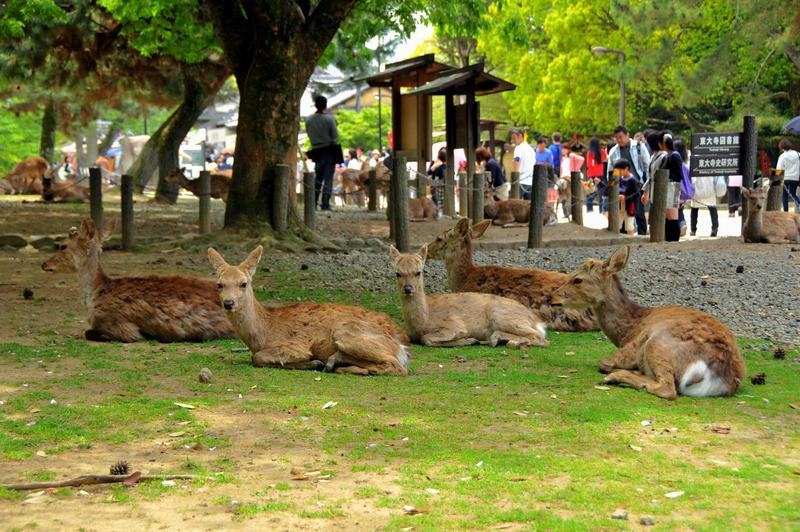 some deer near Todaiji Temple, Nara Park
some deer near Todaiji Temple, Nara Park
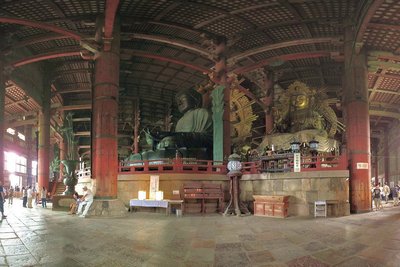
Todaiji Temple
(admission 600¥, opening hours 8-17 nov-mar, 7:30-17:30 apr-oct)
Todaiji Temple is a huge Buddhist temple built in the year 752, as the main temple of all Buddhist temples in Japan, and became so powerful that the capital was moved from Nara to Nagaoka in 784 to reduce the influence of the temple on the affairs of the government. The temple is a UNESCO World Heritage Site and is one of the top wonders to visit in Nara. Today it houses the largest bronze Buddha statue in Japan (Nara Daibutsu, 15 meters), which is located inside the Daibutsu-den which is in turn one of the largest wooden buildings in the world, although today's building is a 1692 reconstruction that is smaller than the original building. The territory belonging to the temple is very extensive and hosts numerous minor temples and other tourist sites. Among them, we recommend dropping by the Nigatsudo Hall, a free-to-entrance building located on the hill east of Daibutsuden Hall that offers good city views from its balcony.
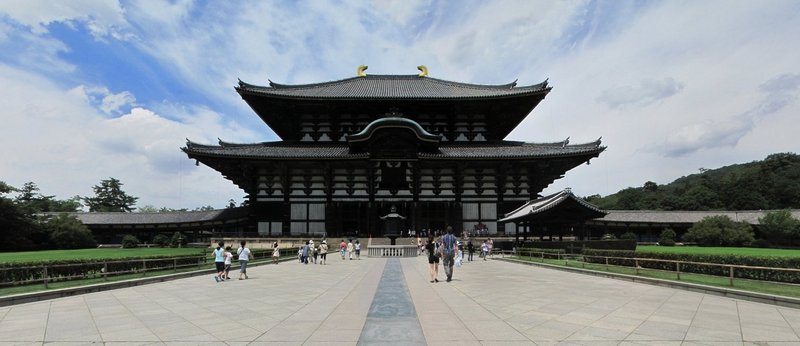 Todaiji Temple
Todaiji Temple
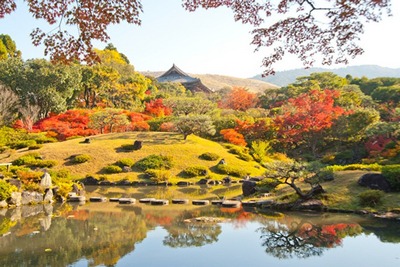
Isuien Garden
(admission 1200¥, opening hours 9:30-16:30, closed on tuesdays)
Isuien Garden is a traditional Japanese garden near Todaiji Temple, next to the Yoshikigawa River that separates this garden from the Yoshikien Garden. An interesting peculiarity is the use of one of the entrance gates of the Todaiji Temple and Mount Wakakusayama as background elements of the garden. Inside you will find several buildings. There is also a small museum within the garden that exhibits ceramics and other ancient artifacts from China and Korea.
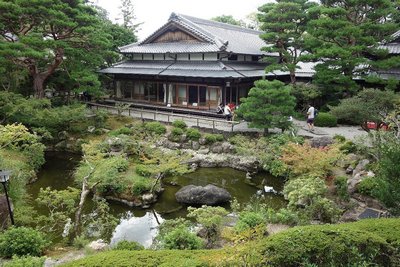
Yoshikien Garden
(free admission, opening hours 9-17)
For those looking for free attractions, always near the Todaiji Temple and on the other side of the Yoshikigawa river, right next to the Isuien Garden, there is this garden that can be visited for free. The garden is in turn divided into three completely different areas. There is a moss garden, a traditional garden around a pond, and a tea ceremony garden. This is an uncommon opportunity in Japan to get a feel for different variations of Japanese gardens in one place.
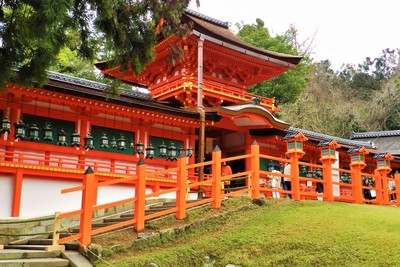
Kasuga Taisha
(free admission, opening hours 6:30-17:30, 7-17 nov-mar)
Kasuga Taisha is the most important Shinto shrine in the city, dating back to 768, when Nara was the country's capital, and dedicated to the deity responsible for protecting the city. It is located in the eastern part of Nara Park and can be reached after a walk along a tree-lined path, with more than a thousand stone lanterns arranged along the way. Hundreds more bronze lanterns, donated by the faithful, hang from the shrine buildings. Part of the shrine is accessible for free, but to approach the main buildings you need to access a paid area (500¥). The main shrine is surrounded by several smaller shrines, scattered in the surrounding woodland. On the grounds of this shrine there are also:
- A botanical garden called Shinen Manyo (admission 500¥, opening hours 9-17, until 16:30 dec-feb), which contains all the 250 species mentioned in the Man'yōshū, an ancient Japanese collection of poems dating back to the Nara Period. The garden is also home to many wisteria flowers that bloom between mid-April and mid-May.
- The Kasuga Taisha Museum (admission 500¥, opening hours 9-17, until 16:30 dec-feb), which preserves the most precious relics of the shrine.
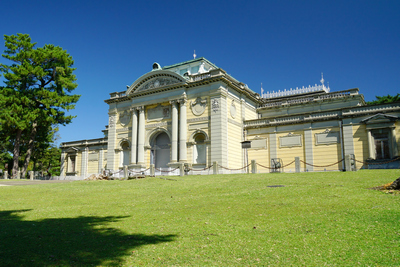
Nara National Museum
(admission 700¥, opening hours 9:30-17:00, closed on mondays)
A museum with a world-leading collection of Japanese Buddhist art. The museum is divided into two buildings, the original building from 1889 and a new building added later, connected internally by an underground passage. The museum's permanent collection includes statues, paintings, scrolls and ceremonial objects.
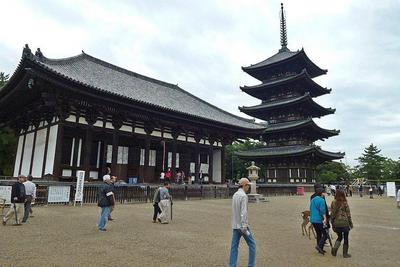
Kofukuji Temple
(opening hours 9-17)
This temple is located near the west side entrance of Nara Park, very close to the railway stations. The temple was founded in 710, the year the city became the capital. It was the personal temple of the Fujiwara clan, the most important family of Japan throughout the Nara Period (710-794). In the moment of greatest splendor it came to include about 150 buildings, while today very little remains of those ancient glories. However, the few remaining buildings have immense historical value. You can walk freely around the temple, but the most important buildings either cannot be visited internally, or require an entrance fee:
- A five story pagoda (closed to the public): 50 meters high, it is the second tallest wooden pagoda in Japan, and is a symbol of the city. First built in 730 and destroyed several times, the latest reconstruction in 1426 survives to this day. Inside the temple there is also another lower pagoda, with three floors.
- Central Golden Hall (500¥): the main temple building, which was destroyed by fire some 300 years ago and never rebuilt to its original size until a few years ago. The reconstruction work was completed in 2018.
- Eastern Golden Hall (300¥): another large building, east of the main building, housing a large statue of Buddha Yakushi.
- National Treasure Museum (700¥): a museum of Buddhist art which preserves and exhibits the treasures held by the temple.
- Octagonal Halls (closed to the public): two very old octagonal buildings, the north building dating from 1210, the south building from 1789.
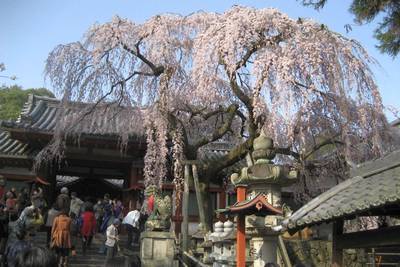
Himuro Shrine
(free admission)
Himuro Shrine is little known and ignored by most, although it is located inside Nara Park, opposite the Nara National Museum. Originally, during the Nara Period, it served as a storage place for ice to be offered to the imperial court in summer. After losing this role, it became a shrine to ice deities, a rare role in Japan. A festival called Kenpyosai is held on May 1 each year, where workers of companies that make and sell ice pray for success in their business. Also, the shrine grounds are home to some very beautiful weeping cherry trees. We recommend a quick visit if you are in Nara in spring during the cherry blossom (hanami) season.
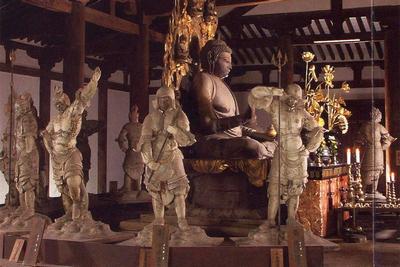
Shin-Yakushiji Temple
(admission 600¥, opening hours 9-17)
Shin-Yakushiji Temple is located just outside Nara Park, walking about five minutes south. It was founded in 747 by Empress Kōmyō and is dedicated today to Yakushi Buddha, the patron saint of medicine in Japanese Buddhism. Unfortunately to date only one building, the main one, has survived from the eighth century to the present day. Inside there is an important series of sculptures: in the center there is a wooden statue almost two meters high of Yakushi Buddha (Yakushi Nyorai), surrounded by 12 other statues (in clay) representing twelve different guardians. It is very interesting to observe the details of each guardian, each one different from the other and with different weapons in hand.
Mount Wakakusa
Mount Wakakusa (若草山, Wakakusayama) is a small mountain covered with green grass just behind Nara Park. The mountain is 342 meters high and offers a great view of the city of Nara. Entry to the shorter trails to the top is fenced off, and an entrance fee must be paid (150¥ open 9am-5pm, closed in winter). There are two entry points (north and south) marked on our city map at the bottom of this page. The slope is lined with cherry trees in full bloom around early April. Many tourists walk only the first part of a steep path, which reaches a grassy plateau halfway up the mountain (it takes 15-20 minutes of uphill walking), with a remarkable view of the city. It takes about another half hour to get to the top. There is nothing special at the top, except a burial mound and a more extensive view. However, the higher areas of the mountain are often frequented by groups of deer who come here to rest after a day of gathering food from tourists. Alternatively, it is possible to get to the summit of Mt. Wakakusa without paying anything, by taking a longer and less scenic path that passes through the
Mt. Kasuga Primeval Forest.
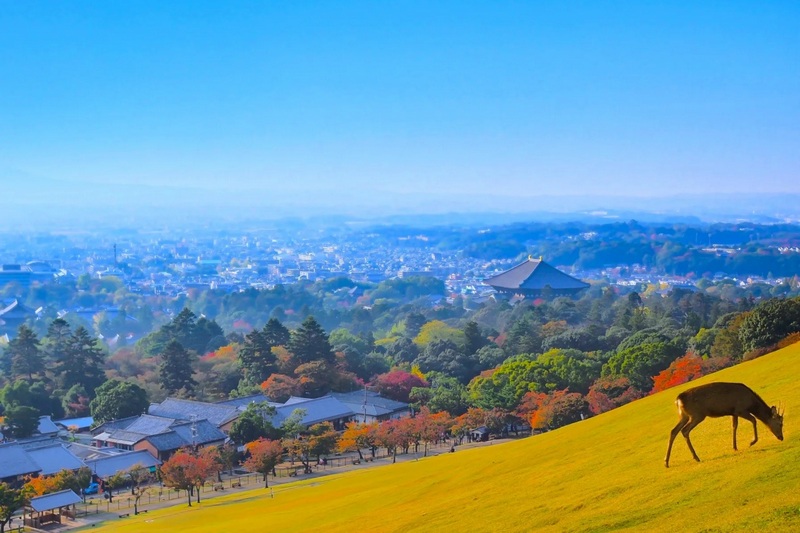 view from the slopes of Mount Wakakusa (credits)
view from the slopes of Mount Wakakusa (credits)
Wakakusa Yamayaki
(When: every fourth Saturday of January)
Every winter, on the fourth Saturday of January, the grass on the slopes of Mount Wakakusayama is burned and the whole mountain seems to magically catch fire, in a day of celebration for the city. The origins of the event are unclear. According to the most accredited theory, the tradition was born in 1760 following a dispute over the boundaries between two temples, Todaiji and Kofukuji. After the mediation failed, the entire mountain would be set on fire. Other hypotheses suggest that the original purpose was the extermination of the wild boars or other animals that inhabited the mountain. The festival today begins with a ceremonial lighting by representatives of both temples, followed by a fireworks display.
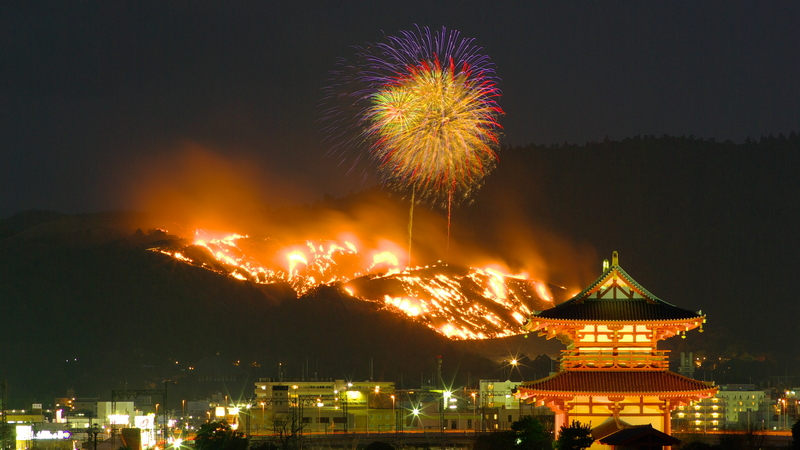 Wakakusa Yamayaki
Wakakusa Yamayaki
Mount Kasuga
Mount Kasuga (春日山, Kasugayama) is another hill about 300 meters high, next to Mount Wakakusa. Unlike the latter, this hill is covered by a dense forest which is called
Mount Kasuga Primeval Forest (春日山原始林). This forest, behind the Kasuga Taisha Shinto shrine, preserves a rare ecosystem that has remained untouched for over 1200 years, both in terms of flora and fauna. In fact, it dates back to the year 841 AD. the prohibition of any hunting or logging activity in the area. There are several trails to explore in this forest. A first option is to briefly cross a patch of forest to reach the nearby summit of Mount Wakakusa with its panoramic view (30-40 minute climb, entrance marked on our map). Along this path, incredible but true, there is also a
luxurious ryokan immersed in the forest where you can stay overnight and eat exquisite dishes of kaiseki cuisine.
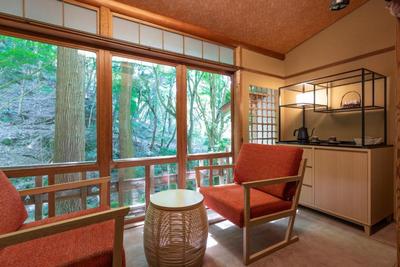
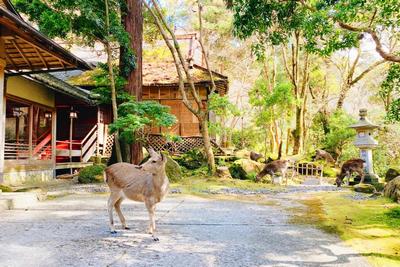 the Ryokan Tsukihitei, surrounded by wild deer, and typical forest view from the rooms
the Ryokan Tsukihitei, surrounded by wild deer, and typical forest view from the rooms
A second option, for lovers of naturalistic excursions, is to follow a longer path (about 10 km in total) which passes by some points of interest such as a cave with Buddhist statues inside, a waterfall (
Uguisuno- taki), and many other small religious altars. In addition to the main path, there are also other small paths, with different entry points that you can easily locate by looking at Google Maps.
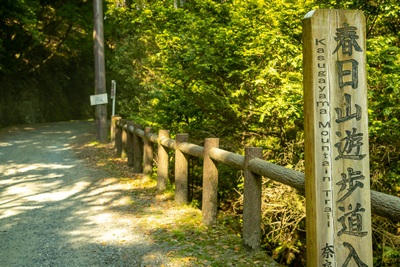
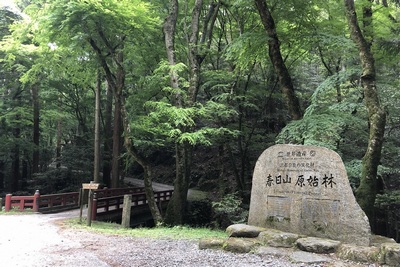
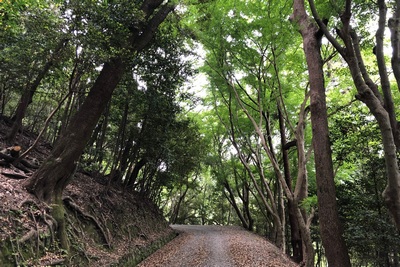
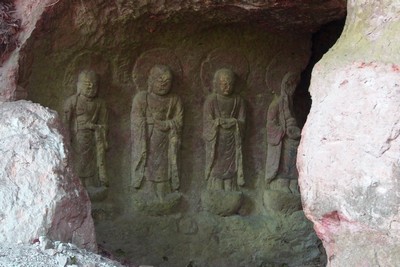 various glimpses along the paths of the Primeval Forest of Mt. Kasuga (credits 1), (credits 2)
various glimpses along the paths of the Primeval Forest of Mt. Kasuga (credits 1), (credits 2)
Naramachi
Naramachi (奈良町) is a small area east of JR Nara Station and south of Kintetsu Nara Station, once the city's merchant district. Today it retains many historic buildings, small temples and shrines, and above all some original
machiya, i.e. the typical merchant houses of feudal Japan. A walk through the streets of the neighborhood is a great way to breathe an air of ancient Japan, do some souvenir shopping and, if interested, visit some of its many small attractions. Some old machiyas retain their ancient appearance and can be visited internally, others house small museums, shops, cafes and restaurants.
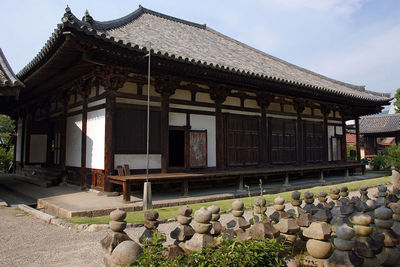
Gangoji Temple
(admission 500¥, opening hours 9-17)
This very ancient temple, once one of the largest and most powerful in the city, is today much smaller, and moreover all the buildings have been destroyed over time and what remains today is almost all the result of various reconstructions over time. Among the treasures held by the temple, there is a curious miniature model of a five-storied pagoda dating from the Nara period (710-794), thought to have been built as a scale model for the many pagodas built in Nara over the following centuries.
Machiya that can be visited
As already mentioned, in the neighborhood there are old merchants' houses open to the public, most of which are free to enter. Below is a list of those we know of (all marked on the map at the bottom):
- Koshi-no-Ie Residence (free admission, 9-17)
- Nigiwai-no-Ie Residence (free admission, 9-17)
- Imanishike Shoin Residence (400¥, 9-17)
- Hosokawa Residence (free admission, 9-17)
- Mori Residence (free admission, 9-17)
Harushika sake brewery
(opening hours 10-17)
An ancient distillery founded in 1884 by the Imanishi family, who lived right next to today's factory in the Imanishike Shoin. Inside, visitors can taste different varieties of sake for 500¥, and take home a sake cup as a souvenir.
Karakuri Omochakan Toy Museum
(free admission, opening hours 9-17)
A small, curious and interesting toy museum run by a non-profit organization. Inside you can not only view but also touch and try to play with a collection of toys dating back to the Edo period (1603-1868). There are about thirty toys on display, which rotate every month out of a total collection of about two hundred objects. Recommended for children and adults.
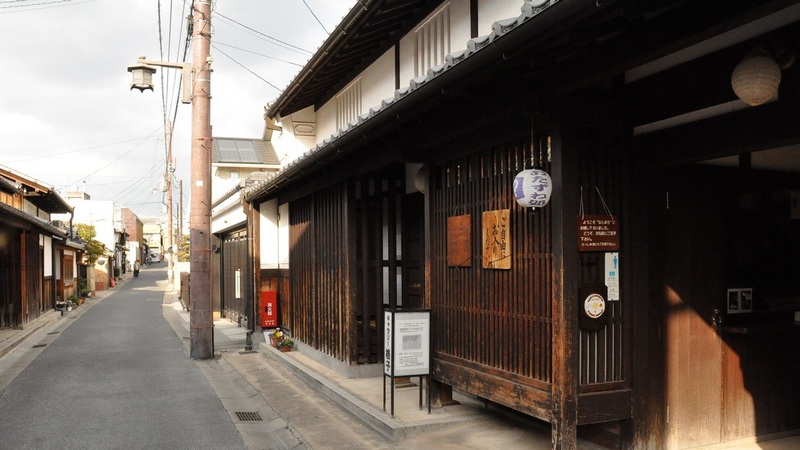 a street in Naramachi with its old wooden houses
a street in Naramachi with its old wooden houses
Heijo Palace (Imperial Palace)
Nara was the country's capital for about 60 years during the Nara Period (710-794). At the time, the city center was built around a huge complex of imperial buildings, the
Heijo Palace, one kilometer wide and another kilometer long. The emperor's residence and government buildings were located here. Today in their place there is a vast archaeological area with some buildings rebuilt over time, as all the original buildings have been destroyed. This area is not very close to the current city center. It is located just east of
Yamato-Saidaiji Station, which can be reached in a few minutes from
Kintetsu Nara station via the
Kintetsu Nara Line, while on foot it takes more than 40 minutes. The fact that this area is located relatively outside the city is no coincidence: when the capital was moved to Kyoto in 784, Heijo Palace and much of the city were abandoned and many citizens moved to the new capital. Temples on the outskirts of the former capital (such as the famous Todaiji), however, retained their importance, and the city of Nara subsequently resumed growth around these temples. The area of the ancient imperial palace, on the contrary, for many centuries was nothing more than an agricultural area. The lack of urban development has paradoxically greatly facilitated archaeological research, which began in the 1950s.
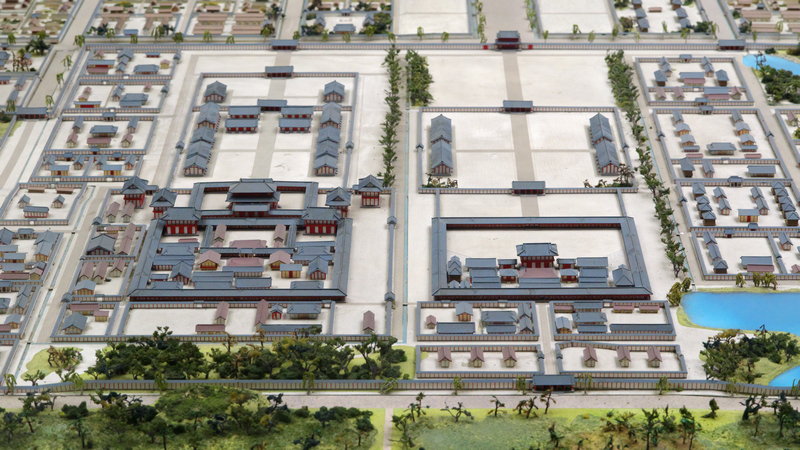 model of Heijo Palace at its heyday during the Nara Period (the miniature reconstruction is located at the Nara City Hall)
model of Heijo Palace at its heyday during the Nara Period (the miniature reconstruction is located at the Nara City Hall)
Today the area, which can be
visited free of charge, looks like an enormous expanse of meadows, with various reconstructions scattered here and there. However, the area is very large and you have to walk a lot in essentially empty spaces. The most famous reconstruction is the
Daigokuden, the largest building in the complex that was used for important ceremonies, rebuilt in 2010 on the occasion of the 1300th anniversary of Nara's coronation as the capital.
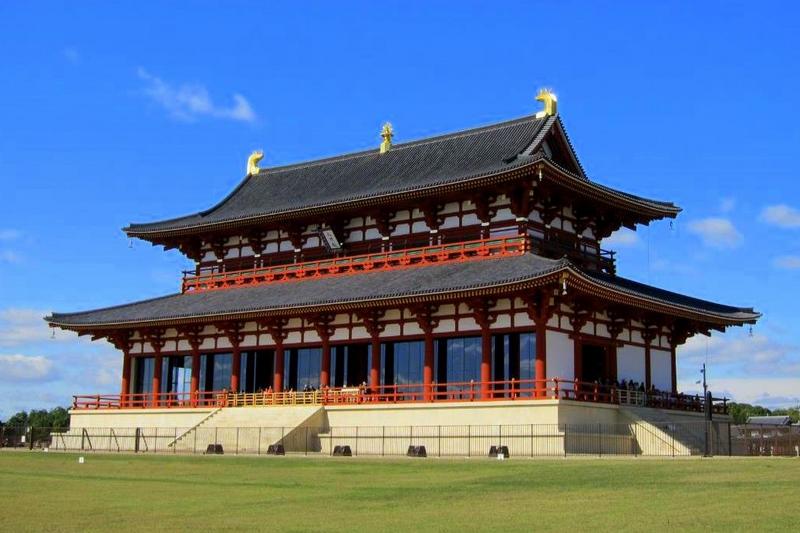 Daigokuden
Daigokuden
Other large reconstructed buildings are the
Suzaku Gate and the
Daigoku Gate (two entrance gates), and the
Toin Teien (East Palace Garden ), a garden with a pond that was used by the imperial family to host banquets. The archaeological remains of the latter were found in 1967 and the garden was rebuilt in 1998.
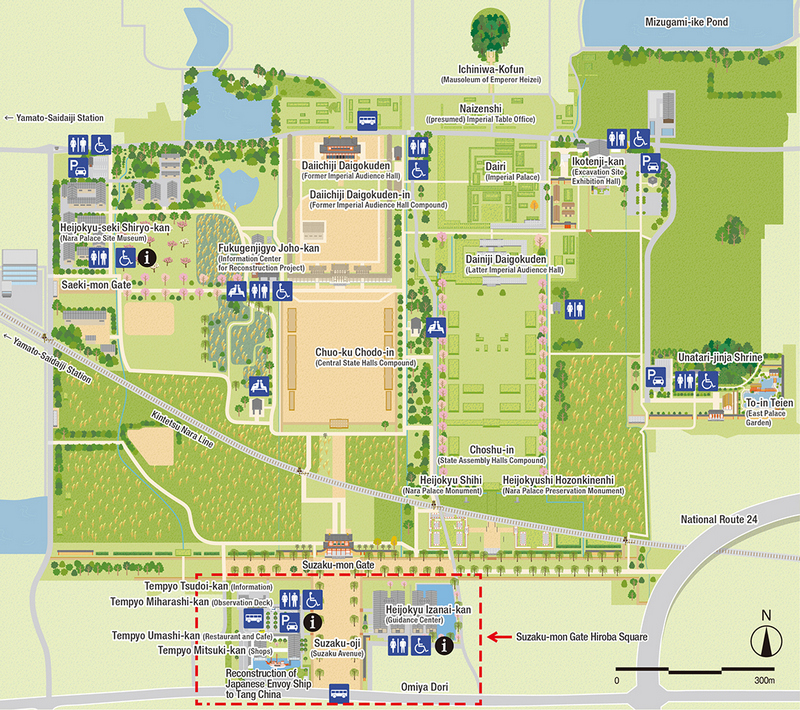 a map of the reconstructed places
a map of the reconstructed places
Museums
In recent decades, several museums and buildings have been built to visit to make visiting the area more and more interesting:
- Suzaku-mon Gate Hiroba Square (free admission). A complex of services and attractions for tourists, located in the south end of the area, in front of the Suzaku Gate. Here you will find a small museum on the Nara Period, a tourist information center, a restaurant, a cafe, a souvenir shop, a virtual reality theater, a panoramic terrace overlooking the park of the ancient palace. Outside, you cannot fail to notice a life-size reconstruction of an ancient ship used for diplomatic relations with China.
- Nara Palace Site Museum (Heijokyu-seki Shiryo-kan) (free admission). A small museum displaying artefacts found in the area, as well as models, photos and maps. It is located at the west end of the park.
- Excavation Site Exhibition Hall (free admission). A structure that preserves some archaeological remains as they were at the time of discovery. It is located in the northeast corner of the area, where the East Palace once stood.
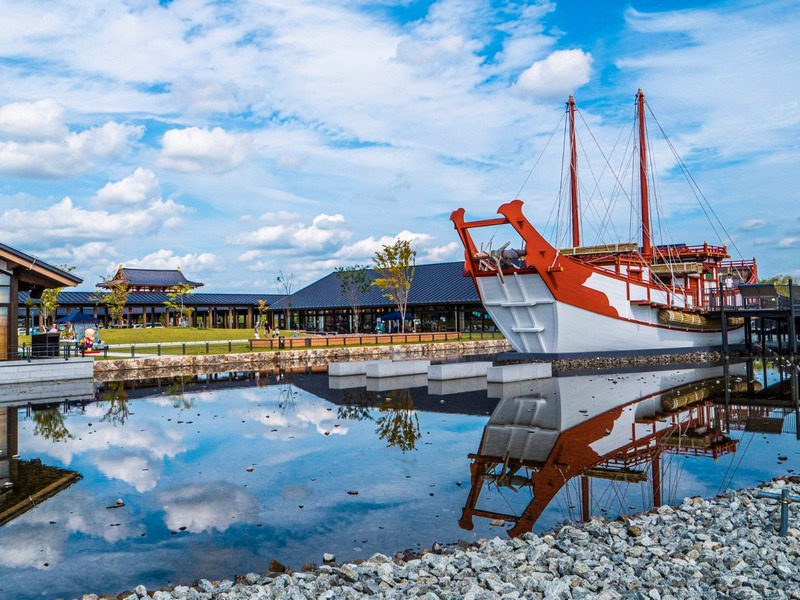 Suzaku-mon Gate Hiroba Square
Suzaku-mon Gate Hiroba Square
West Nara: Toshodaiji and Yakushiji
Near
Nishinokyō Station there are two important temples, the Yakushiji and the Toshodaiji. The area can be reached by train from Kintetsu Nara station by taking the
Kintetsu Nara line to
Yamato-Saidaiji station and changing there to the
Kintetsu Kashihara Line (about 15 minutes in total). Alternatively, some city buses pass through this area from outside Nara's JR and Kintetsu Stations (similar journey times and fares to the train). Toshodaiji is 700 metres north of the station, Yakushiji 300 metres south.
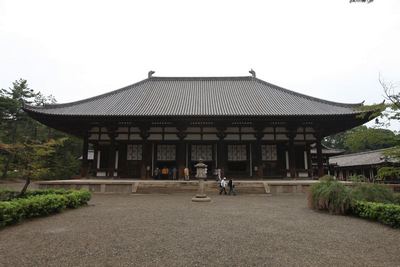
Toshodaiji Temple
(admission 1000¥, opening hours 8:30-17:00)
Another important temple in Nara, part of the UNESCO World Heritage Site. It was founded way back in 759 by a Chinese monk, Jianzhen (Ganjin), who arrived in Japan at the invitation of the emperor to help develop the Japanese Buddhist movement. He is considered a very important historical figure in the introduction of Buddhism in Japan. His grave is located inside this temple. The temple also preserves an ancient wooden statue of Ganjin: the original is displayed to the public only once a year for a few days around June 6, the anniversary of Ganjin's death, while the rest of the year you can see a reproduction. This temple also houses the only original building of the former imperial palace (Heijo Palace), dating back to the eighth century. All the original buildings in the Palace area have been destroyed, except for this building (Lecture Hall, Kodo) which was relocated here and thus managed to survive over 1200 years.
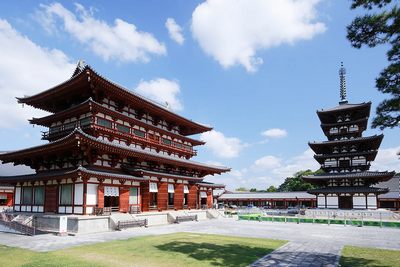
Yakushiji Temple
(admission 1100¥, opening hours 8-17)
A temple complex, founded in the year 680 to pray for the recovery of the sick wife of the emperor. It is characterized by a rigorously symmetrical plan, with two three-story pagodas built on either side of the main building. The east pagoda is the only original building in the whole complex, built in the year 730, while the rest of the buildings have been destroyed and rebuilt throughout history. The temple is now the seat of the Hosso sect of Buddhism. Also belonging to this complex is the Genjo-sanzoin Garan, a temple complex just north of the main temple, built in 1981 and dedicated to the Chinese monk Genjo-sanzo. Genjo-sanzo's teachings have had a profound influence on the history of the Hosso sect.
South of Nara: the town of Ikaruga
About 10 kilometers from the center of Nara is the small town of Ikaruga. The only train station in the area is
Horyuji Station on the
JR Yamatoji Line (12 minutes from JR Nara Station). Unfortunately this station is not very close to the main places of interest in the town, so you have to walk 20 to 30 minutes or take a local bus. This town is home to two UNESCO World Heritage-listed temples: the
Hōryū-ji and the
Hokki-ji temples. One of the main reasons that led to their recognition was that these temples retain some of the
oldest existing wooden buildings in the world, dating back to the 7th-8th century. Other large and important temples in the area are the
Hōrin-ji and the
Chūgū-ji. Finally, Ikaruga is home to the
Fujinoki Tomb, a large mound, known as kofun in Japanese, which is estimated to date back to a period between the 4th and 6th centuries. The mound has a diameter of about 50 meters and a height of 9 meters. The tomb was found during some archaeological excavations in 1985, containing a sixteen-metre long stone coffin covered by the mound, and various bronze ornaments and horse harnesses. Two people were buried inside, but their identity is not clear. According to the most accredited thesis they would be two princes of the time, Prince Anahobe (died assassinated in 587) and Prince Yakabe (son of Emperor Senka).
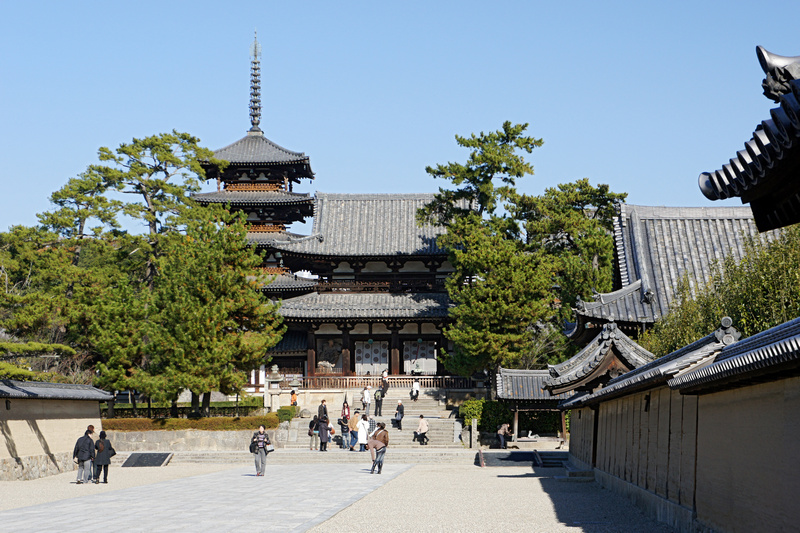 Hōryū-ji Temple
Hōryū-ji Temple
Where to stay in Nara
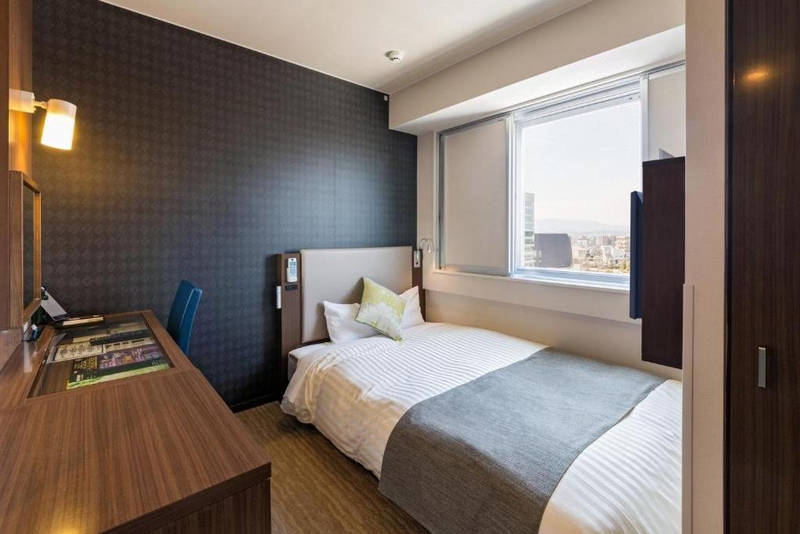 If you simply want a modern, comfortable hotel close to the station, with excellent value for money, where you can spend a night in Nara before leaving for your next destination, the Super Hotel Lohas opposite JR Nara station is our favorite. On the one hand it is literally opposite the station (in case of rain you can move between the hotel and the station without getting wet) and a pleasant 10-15 minute walk to Nara Park. On the other hand, the value for money is hard to beat in the city: modern rooms (some with a decent panoramic view if you ask for the higher floors), well-equipped, possibility to choose from many pillows of different heights and hardnesses, welcome drink, spacious onsen free for all guests, amazing breakfast buffet for only 1000¥ per person.
Price range: single rooms 7,000-8,000¥, double rooms 8,000-10,000¥.
If you simply want a modern, comfortable hotel close to the station, with excellent value for money, where you can spend a night in Nara before leaving for your next destination, the Super Hotel Lohas opposite JR Nara station is our favorite. On the one hand it is literally opposite the station (in case of rain you can move between the hotel and the station without getting wet) and a pleasant 10-15 minute walk to Nara Park. On the other hand, the value for money is hard to beat in the city: modern rooms (some with a decent panoramic view if you ask for the higher floors), well-equipped, possibility to choose from many pillows of different heights and hardnesses, welcome drink, spacious onsen free for all guests, amazing breakfast buffet for only 1000¥ per person.
Price range: single rooms 7,000-8,000¥, double rooms 8,000-10,000¥.
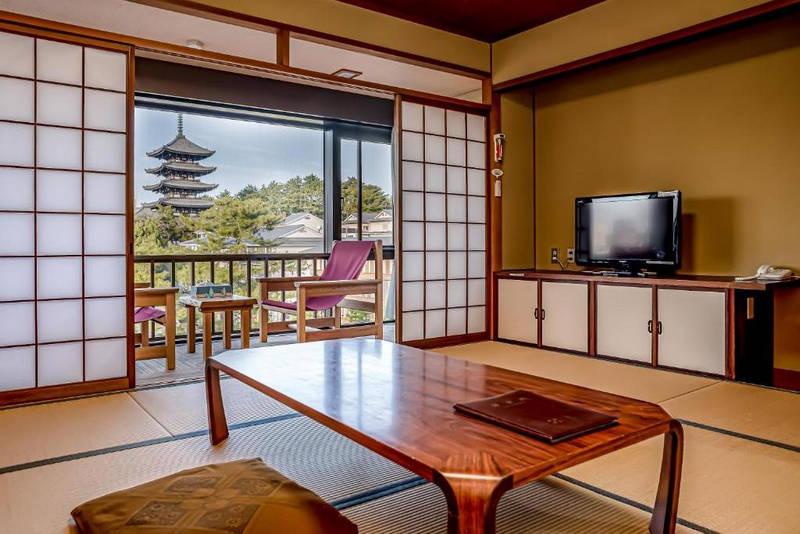 This hotel/visitor center is located next to the legendary Nara Park, while Kintetsu Station and JR Station are an 8-minute and 15-minute walk away respectively. The building offers a spacious and well-equipped common kitchen, washing machines, an onsen, and a konbini shop in the basement. The rooms, available in both Western and Japanese styles, are incredibly spacious for the price they ask. Many of these rooms also have a lovely view of the Kofukuji Temple pagoda. Furthermore, being also a visitor center, various cultural activities and city tours are organized on site. The staff, who speak excellent English, will do their utmost to resolve any doubts or problems you may have. It's like having a tourist information center instead of a reception.
Price range: single rooms 4,200-5,000¥, double rooms 7,000-8,000¥.
This hotel/visitor center is located next to the legendary Nara Park, while Kintetsu Station and JR Station are an 8-minute and 15-minute walk away respectively. The building offers a spacious and well-equipped common kitchen, washing machines, an onsen, and a konbini shop in the basement. The rooms, available in both Western and Japanese styles, are incredibly spacious for the price they ask. Many of these rooms also have a lovely view of the Kofukuji Temple pagoda. Furthermore, being also a visitor center, various cultural activities and city tours are organized on site. The staff, who speak excellent English, will do their utmost to resolve any doubts or problems you may have. It's like having a tourist information center instead of a reception.
Price range: single rooms 4,200-5,000¥, double rooms 7,000-8,000¥.
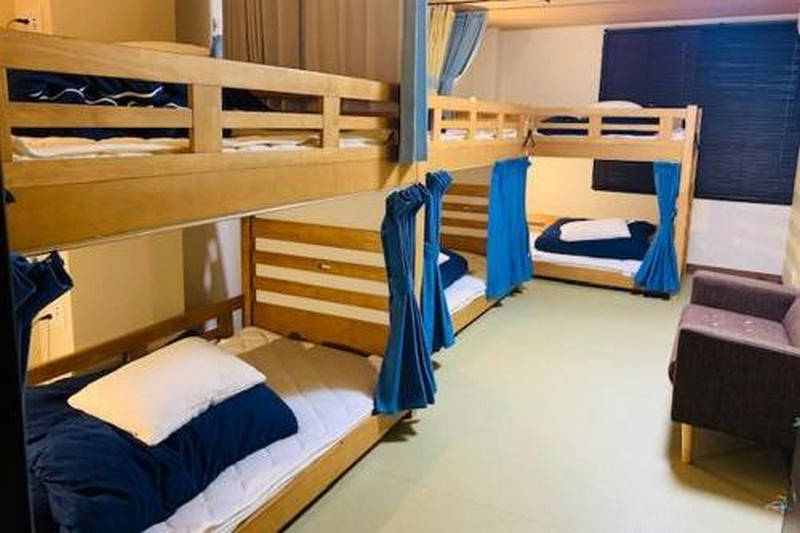 A hostel 300 meters from JR Nara station and with a family atmosphere, run by an extremely kind couple who are always available to help you and give advice of any kind. The hostel is one of the lowest priced accommodation in the central area of the city, and offers beds in six-bed mixed dormitory, beds in four-bed female-only dormitory, and private rooms that can accommodate up to three people. In the common area there are tea and coffee, a fridge, a microwave and a kitchen.
Price range: bunk beds 2,900-3,300¥.
A hostel 300 meters from JR Nara station and with a family atmosphere, run by an extremely kind couple who are always available to help you and give advice of any kind. The hostel is one of the lowest priced accommodation in the central area of the city, and offers beds in six-bed mixed dormitory, beds in four-bed female-only dormitory, and private rooms that can accommodate up to three people. In the common area there are tea and coffee, a fridge, a microwave and a kitchen.
Price range: bunk beds 2,900-3,300¥.
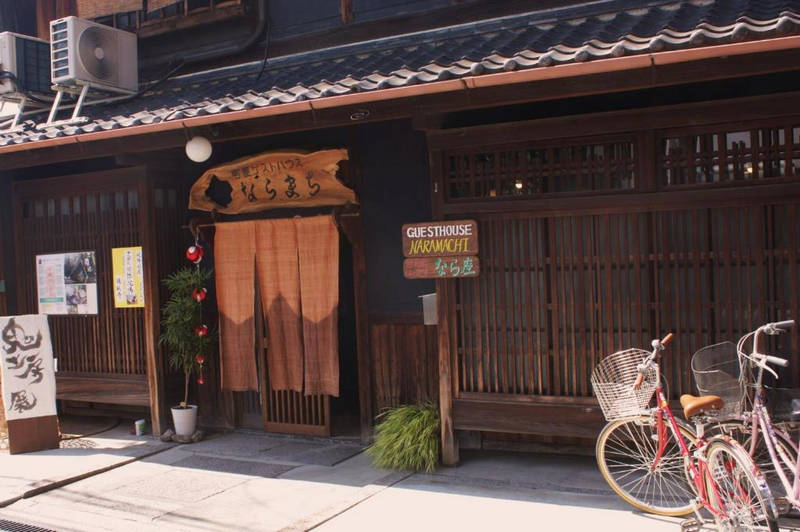 Spending a night at this guesthouse is one of those experiences that doesn't happen every day. The guesthouse is an old merchant's house, all in wood, built over a hundred years ago and miraculously survived in a quiet residential area of Nara. The JR station is about 20 minutes' walk, Nara Park and the Kintetsu station about 15 minutes away. There is also a convenient bus stop in front of the hotel, and the hotel also rents bikes, with which it is easy and fun to explore the city, for only 500¥ per day. In this guesthouse you will find delightful rooms furnished in Japanese style, which can accommodate from one to four people, and a common room with bathroom, fridge, microwave and other small comforts. The guesthouse is family run and the couple who run it is lovely and will do anything to help you and make your stay a pleasant one.
Price range: one person 5,000-6,000¥, two people 7,000-8,000¥.
Spending a night at this guesthouse is one of those experiences that doesn't happen every day. The guesthouse is an old merchant's house, all in wood, built over a hundred years ago and miraculously survived in a quiet residential area of Nara. The JR station is about 20 minutes' walk, Nara Park and the Kintetsu station about 15 minutes away. There is also a convenient bus stop in front of the hotel, and the hotel also rents bikes, with which it is easy and fun to explore the city, for only 500¥ per day. In this guesthouse you will find delightful rooms furnished in Japanese style, which can accommodate from one to four people, and a common room with bathroom, fridge, microwave and other small comforts. The guesthouse is family run and the couple who run it is lovely and will do anything to help you and make your stay a pleasant one.
Price range: one person 5,000-6,000¥, two people 7,000-8,000¥.
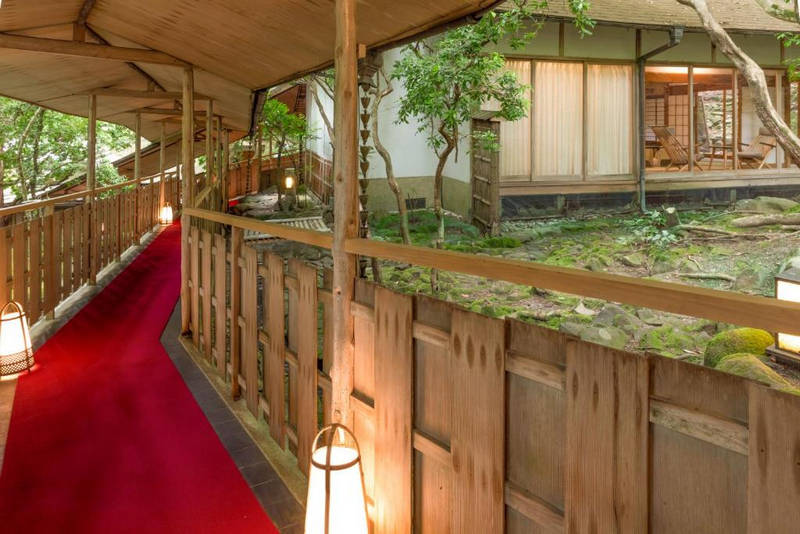 Behind the famous Shinto shrine known as Kasuga Taisha lies the Primeval Forest of Mount Kasuga, a vast area where logging and hunting have been prohibited for over 1200 years and today populated by numerous animal species, including shika deer. Miraculously, within this forest there is a building, which is now a luxurious ryokan surrounded by nature. Prices are sky-high, but they include a large traditional breakfast and kaiseki dinner of a standard that is more like a work of art than a meal. These prices are not for everyone and you pay not only for the level of services (very high but elsewhere you would spend less for the same level) but also for the uniqueness of the location. If you have the budget, a night here is one of those experiences you will remember for the rest of your life.
Price range: room for two people with breakfast and dinner included 80,000-90,000¥.
Behind the famous Shinto shrine known as Kasuga Taisha lies the Primeval Forest of Mount Kasuga, a vast area where logging and hunting have been prohibited for over 1200 years and today populated by numerous animal species, including shika deer. Miraculously, within this forest there is a building, which is now a luxurious ryokan surrounded by nature. Prices are sky-high, but they include a large traditional breakfast and kaiseki dinner of a standard that is more like a work of art than a meal. These prices are not for everyone and you pay not only for the level of services (very high but elsewhere you would spend less for the same level) but also for the uniqueness of the location. If you have the budget, a night here is one of those experiences you will remember for the rest of your life.
Price range: room for two people with breakfast and dinner included 80,000-90,000¥.
How to get to Nara
Nara has two main railway stations: one of the state-owned company JR (Japan Railways), the other of the private company Kintetsu Railways. Both can be easily reached from Osaka and Kyoto, the two closest cities from which a day trip to Nara is usually set off. The two stations are located about 1 km away from each other, Kintetsu station is the more convenient of the two because it is closer to Nara Park, the most famous place in the city.
From Osaka
- The Yamatoji line connects Nara with various major stations in Osaka: Osaka station (780¥, 50 minutes), Namba station (540¥, 43 minutes), Tennoji station (450¥, 30 minutes). These journey times refer to Rapid Service trains (大和路快速), there are also local trains (普通) which take longer.
- From Osaka Namba station you can take the Kintetsu Nara Line. There are limited express trains that require a seat reservation (1040¥, 30 minuti) and express trains for which you do not need it (540¥, 40 minutes).
From Kyoto
- The JR Nara Line connects Kyoto station to JR Nara Station (690¥). Also in this case, be careful to take the "Rapid" trains (journey time 45-50 minutes) rather than the "Local" ones (journey time 75-80 minutes).
- La Kintetsu Kyoto line connects Kyoto station to Kintetsu Nara Station. There are limited express trains that require a seat reservation (1110¥, 35 minutes) and express trains for which you do not need it (610¥, 45 minutes). Express trains are not very frequent (one every hour or so).
Map of Nara, Kansai
Guided tours, activities and other things to do
If you are planning a trip to Japan and you want to do something more than just visiting famous places and monuments, we suggest you to use
Rakuten Travel Experiences.
How to use Rakuten Travel Experiences
Rakuten Travel is a very useful website to
enrich your travel experience, especially if you are going solo or it's your first time in Japan.
Because of the language barrier (and more), in Japan it is very difficult to interact with the locals and to get off the tourist track.
Thanks to Rakuten Travel you can find a lot of interesting and sometimes unique
guided tours and activities all over Japan (and not only in Japan), that you would otherwise never be able to enjoy.
But there's more: on Rakuten Travel you can also
buy tickets for several famous attractions, events, transportation and other useful services for tourists. Last but not least, you can
reserve a table in hundreds of restaurants.
Some examples
Take a look at Rakuten Travel Experiences
You may also be interested in








 view from the slopes of Mount Wakakusa (credits)
view from the slopes of Mount Wakakusa (credits)

 model of Heijo Palace at its heyday during the Nara Period (the miniature reconstruction is located at the Nara City Hall)
model of Heijo Palace at its heyday during the Nara Period (the miniature reconstruction is located at the Nara City Hall)


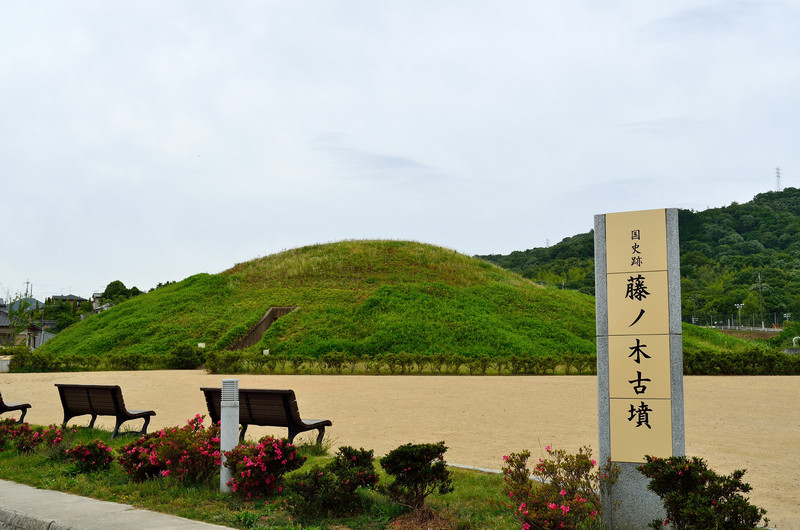 Fujinoki Tomb (credits)
Fujinoki Tomb (credits)
 If you simply want a modern, comfortable hotel close to the station, with excellent value for money, where you can spend a night in Nara before leaving for your next destination, the Super Hotel Lohas opposite JR Nara station is our favorite. On the one hand it is literally opposite the station (in case of rain you can move between the hotel and the station without getting wet) and a pleasant 10-15 minute walk to Nara Park. On the other hand, the value for money is hard to beat in the city: modern rooms (some with a decent panoramic view if you ask for the higher floors), well-equipped, possibility to choose from many pillows of different heights and hardnesses, welcome drink, spacious onsen free for all guests, amazing breakfast buffet for only 1000¥ per person.
Price range: single rooms 7,000-8,000¥, double rooms 8,000-10,000¥.
If you simply want a modern, comfortable hotel close to the station, with excellent value for money, where you can spend a night in Nara before leaving for your next destination, the Super Hotel Lohas opposite JR Nara station is our favorite. On the one hand it is literally opposite the station (in case of rain you can move between the hotel and the station without getting wet) and a pleasant 10-15 minute walk to Nara Park. On the other hand, the value for money is hard to beat in the city: modern rooms (some with a decent panoramic view if you ask for the higher floors), well-equipped, possibility to choose from many pillows of different heights and hardnesses, welcome drink, spacious onsen free for all guests, amazing breakfast buffet for only 1000¥ per person.
Price range: single rooms 7,000-8,000¥, double rooms 8,000-10,000¥.
 This hotel/visitor center is located next to the legendary Nara Park, while Kintetsu Station and JR Station are an 8-minute and 15-minute walk away respectively. The building offers a spacious and well-equipped common kitchen, washing machines, an onsen, and a konbini shop in the basement. The rooms, available in both Western and Japanese styles, are incredibly spacious for the price they ask. Many of these rooms also have a lovely view of the Kofukuji Temple pagoda. Furthermore, being also a visitor center, various cultural activities and city tours are organized on site. The staff, who speak excellent English, will do their utmost to resolve any doubts or problems you may have. It's like having a tourist information center instead of a reception.
Price range: single rooms 4,200-5,000¥, double rooms 7,000-8,000¥.
This hotel/visitor center is located next to the legendary Nara Park, while Kintetsu Station and JR Station are an 8-minute and 15-minute walk away respectively. The building offers a spacious and well-equipped common kitchen, washing machines, an onsen, and a konbini shop in the basement. The rooms, available in both Western and Japanese styles, are incredibly spacious for the price they ask. Many of these rooms also have a lovely view of the Kofukuji Temple pagoda. Furthermore, being also a visitor center, various cultural activities and city tours are organized on site. The staff, who speak excellent English, will do their utmost to resolve any doubts or problems you may have. It's like having a tourist information center instead of a reception.
Price range: single rooms 4,200-5,000¥, double rooms 7,000-8,000¥.
 A hostel 300 meters from JR Nara station and with a family atmosphere, run by an extremely kind couple who are always available to help you and give advice of any kind. The hostel is one of the lowest priced accommodation in the central area of the city, and offers beds in six-bed mixed dormitory, beds in four-bed female-only dormitory, and private rooms that can accommodate up to three people. In the common area there are tea and coffee, a fridge, a microwave and a kitchen.
Price range: bunk beds 2,900-3,300¥.
A hostel 300 meters from JR Nara station and with a family atmosphere, run by an extremely kind couple who are always available to help you and give advice of any kind. The hostel is one of the lowest priced accommodation in the central area of the city, and offers beds in six-bed mixed dormitory, beds in four-bed female-only dormitory, and private rooms that can accommodate up to three people. In the common area there are tea and coffee, a fridge, a microwave and a kitchen.
Price range: bunk beds 2,900-3,300¥.
 Spending a night at this guesthouse is one of those experiences that doesn't happen every day. The guesthouse is an old merchant's house, all in wood, built over a hundred years ago and miraculously survived in a quiet residential area of Nara. The JR station is about 20 minutes' walk, Nara Park and the Kintetsu station about 15 minutes away. There is also a convenient bus stop in front of the hotel, and the hotel also rents bikes, with which it is easy and fun to explore the city, for only 500¥ per day. In this guesthouse you will find delightful rooms furnished in Japanese style, which can accommodate from one to four people, and a common room with bathroom, fridge, microwave and other small comforts. The guesthouse is family run and the couple who run it is lovely and will do anything to help you and make your stay a pleasant one.
Price range: one person 5,000-6,000¥, two people 7,000-8,000¥.
Spending a night at this guesthouse is one of those experiences that doesn't happen every day. The guesthouse is an old merchant's house, all in wood, built over a hundred years ago and miraculously survived in a quiet residential area of Nara. The JR station is about 20 minutes' walk, Nara Park and the Kintetsu station about 15 minutes away. There is also a convenient bus stop in front of the hotel, and the hotel also rents bikes, with which it is easy and fun to explore the city, for only 500¥ per day. In this guesthouse you will find delightful rooms furnished in Japanese style, which can accommodate from one to four people, and a common room with bathroom, fridge, microwave and other small comforts. The guesthouse is family run and the couple who run it is lovely and will do anything to help you and make your stay a pleasant one.
Price range: one person 5,000-6,000¥, two people 7,000-8,000¥.
 Behind the famous Shinto shrine known as Kasuga Taisha lies the Primeval Forest of Mount Kasuga, a vast area where logging and hunting have been prohibited for over 1200 years and today populated by numerous animal species, including shika deer. Miraculously, within this forest there is a building, which is now a luxurious ryokan surrounded by nature. Prices are sky-high, but they include a large traditional breakfast and kaiseki dinner of a standard that is more like a work of art than a meal. These prices are not for everyone and you pay not only for the level of services (very high but elsewhere you would spend less for the same level) but also for the uniqueness of the location. If you have the budget, a night here is one of those experiences you will remember for the rest of your life.
Price range: room for two people with breakfast and dinner included 80,000-90,000¥.
Behind the famous Shinto shrine known as Kasuga Taisha lies the Primeval Forest of Mount Kasuga, a vast area where logging and hunting have been prohibited for over 1200 years and today populated by numerous animal species, including shika deer. Miraculously, within this forest there is a building, which is now a luxurious ryokan surrounded by nature. Prices are sky-high, but they include a large traditional breakfast and kaiseki dinner of a standard that is more like a work of art than a meal. These prices are not for everyone and you pay not only for the level of services (very high but elsewhere you would spend less for the same level) but also for the uniqueness of the location. If you have the budget, a night here is one of those experiences you will remember for the rest of your life.
Price range: room for two people with breakfast and dinner included 80,000-90,000¥.